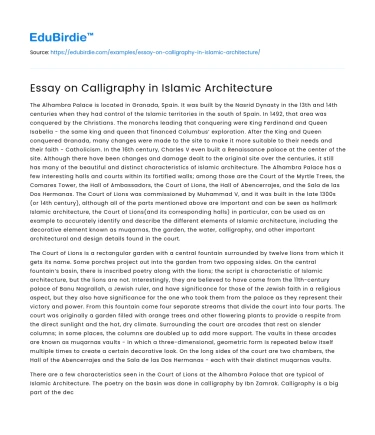The Alhambra Palace is located in Granada, Spain. It was built by the Nasrid Dynasty in the 13th and 14th centuries when they had control of the Islamic territories in the south of Spain. In 1492, that area was conquered by the Christians. The monarchs leading that conquering were King Ferdinand and Queen Isabella - the same king and queen that financed Columbus’ exploration. After the King and Queen conquered Granada, many changes were made to the site to make it more suitable to their needs and their faith - Catholicism. In the 16th century, Charles V even built a Renaissance palace at the center of the site. Although there have been changes and damage dealt to the original site over the centuries, it still has many of the beautiful and distinct characteristics of Islamic architecture. The Alhambra Palace has a few interesting halls and courts within its fortified walls; among those are the Court of the Myrtle Trees, the Comares Tower, the Hall of Ambassadors, the Court of Lions, the Hall of Abencerrajes, and the Sala de las Dos Hermanas. The Court of Lions was commissioned by Muhammad V, and it was built in the late 1300s (or 14th century), although all of the parts mentioned above are important and can be seen as hallmark Islamic architecture, the Court of Lions(and its corresponding halls) in particular, can be used as an example to accurately identify and describe the different elements of Islamic architecture, including the decorative element known as muqarnas, the garden, the water, calligraphy, and other important architectural and design details found in the court.
The Court of Lions is a rectangular garden with a central fountain surrounded by twelve lions from which it gets its name. Some porches project out into the garden from two opposing sides. On the central fountain’s basin, there is inscribed poetry along with the lions; the script is characteristic of Islamic architecture, but the lions are not. Interestingly, they are believed to have come from the 11th-century palace of Banu Nagrallah, a Jewish ruler, and have significance for those of the Jewish faith in a religious aspect, but they also have significance for the one who took them from the palace as they represent their victory and power. From this fountain come four separate streams that divide the court into four parts. The court was originally a garden filled with orange trees and other flowering plants to provide a respite from the direct sunlight and the hot, dry climate. Surrounding the court are arcades that rest on slender columns; in some places, the columns are doubled up to add more support. The vaults in these arcades are known as muqarnas vaults - in which a three-dimensional, geometric form is repeated below itself multiple times to create a certain decorative look. On the long sides of the court are two chambers, the Hall of the Abencerrajes and the Sala de las Dos Hermanas - each with their distinct muqarnas vaults.
Save your time!
We can take care of your essay
- Proper editing and formatting
- Free revision, title page, and bibliography
- Flexible prices and money-back guarantee
There are a few characteristics seen in the Court of Lions at the Alhambra Palace that are typical of Islamic Architecture. The poetry on the basin was done in calligraphy by Ibn Zamrak. Calligraphy is a big part of the decoration seen in Islamic architecture, as it acts as stained glass windows or paintings in Christian buildings did - to tell stories and teach lessons. In the case of the Court of Lions, the poetry on the fountain tells of the garden and its symbolic value; it also praises the patron of the court, Muhammad V. Other examples of calligraphy in Islamic Architecture can be seen in the Hagia Sophia(after it was converted into a mosque) and the Mosque of Suleyman. Another characteristic of the Court of Lions that points to it being Islamic architecture is the muqarnas vault. While the muqarnas vault has no real symbolic value, it has been used as a decorative element in many pieces of Islamic Architecture, including the Mosque of Suleyman that was mentioned above. Additionally, there is the fountain and the water channels. From the central fountain come four streams that split the court into four equal parts. The idea of a walled garden having a fountain in the center that is divided by four streams of water originated in Persia. That idea was inspired by the Qur’an in which paradise is described as a garden with four rivers - one of water, one of milk, one of wine, and one of honey. Comment by Tracy Tannehill:
The Court of Lions is a beautiful example of Islamic architecture found at the Alhambra Palace in Granada, Spain. It is one of the best-preserved sections of the palace after the area was conquered by Ferdinand and Isabella. It has many beautiful elements that have stood the test of time - the muqarnas vaults, the fountain and streams, and the calligraphy. I only wish that we could see the court when it was truly a paradise garden - filled to the brim with orange trees and other flowering plants, with the sound of water and the fragrant scents. It must have been magnificent then - when it was at its true potential. We get to see a glimpse into the past with the elements that are left, but what is missing could show us something entirely new.
“On my honor, as an Aggie, I have neither given nor received unauthorized aid on this academic work.”






 Stuck on your essay?
Stuck on your essay?

